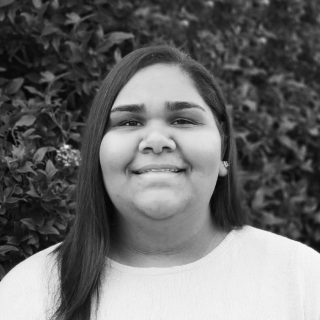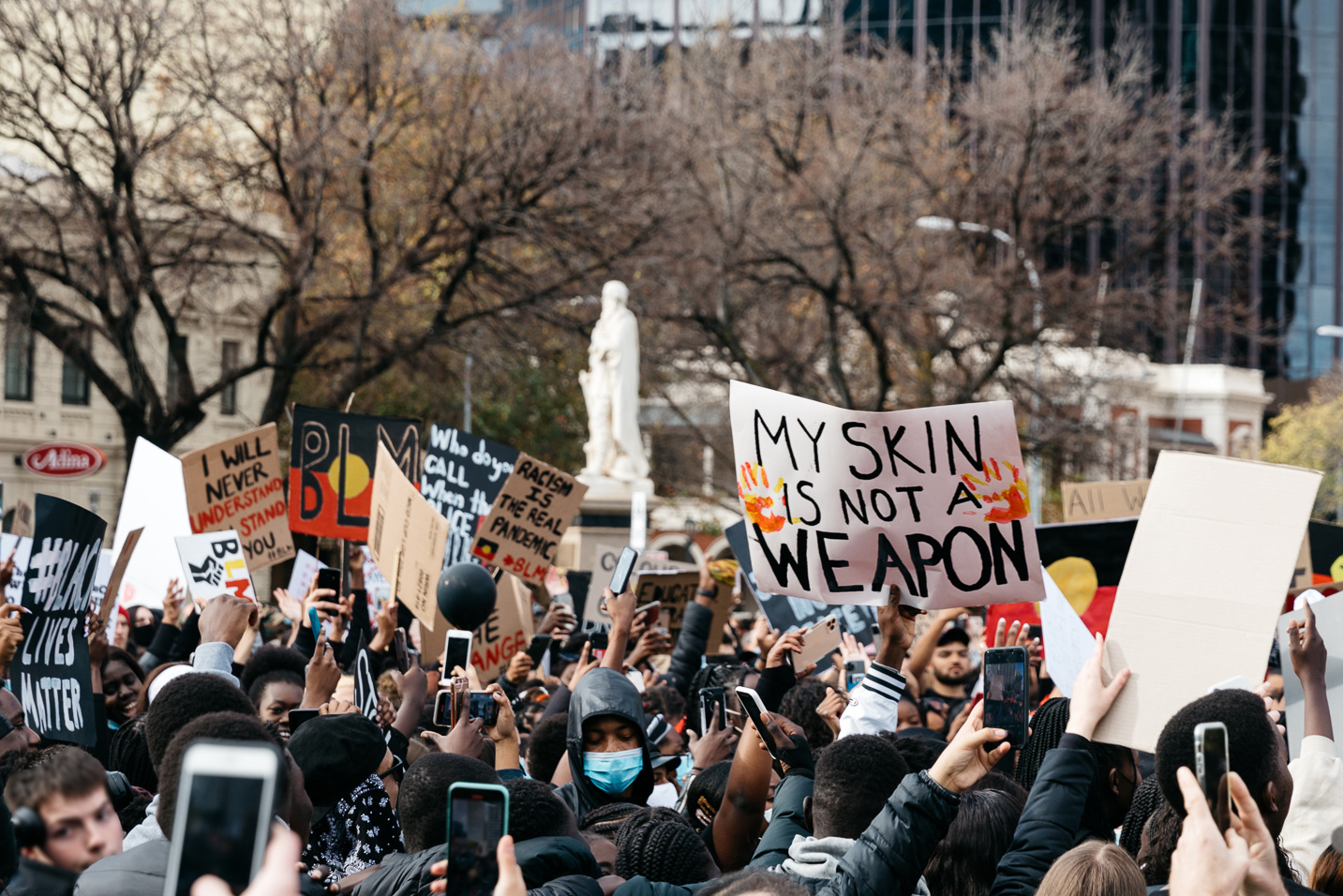
Jacinta Koolmatrie
Jacinta is an Adnyamathanha and Ngarrindjeri person working in the heritage sector.

First Nations people will never be able to heal from the trauma of this country’s colonial past – and its impact on the present – when it’s held up on a pedestal.
A week ago, social media lit up with a video of a Black person standing on the former plinth of slave trader Edward Colston. Moments earlier, Colston had been rolled down the street and dropped into a new resting place – at the bottom of Bristol harbour. The image of a Black person standing where a slave trader once stood shouting “we need to start a revolution” brought tears to my eyes.
Soon more statues were being ripped down by authorities and protestors, from confederate leaders in America’s south to a British naval captain involved in New Zealand frontier wars. It is no coincidence that the removal of statues has re-emerged out of the Black Lives Matter protests, when many of the people memorialised in these statues have aided in the oppression of Black and First Nations people. Their removal is a clear message from the people of these societies, that this is not what they want to memorialise in their public spaces, and oppression should not be celebrated.
Seeing these statues of oppressors topple to the ground, I decided to tweet about one local example I knew about. Coincidentally, this person is commemorated in the same location that the Black Lives Matter rally was held in last weekend, Tarntanyangga (Victoria Square).
Charles Cameron Kingston was a lawyer and politician active in the late 19th and early 20th centuries, a Premier and the first federal Member for Adelaide. He was a deeply divisive figure in his own time, with a history of violent public encounters and rivalries exemplified by an incident in 1892, when he strolled into Tarntanyangga, near where his statue now stands, with a “fully-loaded revolver” to face a parliamentary rival he had challenged to an illegal duel. He was promptly arrested, and eventually placed under a 12-month bond. He became Premier just a few months later.
Kingston was also a racist, and instrumental in the development of the White Australia Policy, one of many racist tranches of Australia’s federation process. Today he is celebrated for the many ‘great’ developments he made on Kaurna Yerta, but these achievements cannot be separated from policies that specifically disadvantaged people of colour. It would also be naive to think that the racialised thinking that was used to create that policy has not continued to shape the prejudice faced by both First Nations people and all people of colour in this country today.
His legacy is a racist one, but you wouldn’t know it from his statue’s proud stance or plaque, which simply reads “patriot and statesman”.
“These types of statues and monuments often hide and ignore the pain that the men or events they are commemorating have caused to First Nation people.” – Nathan Sentance
One of the main arguments against removing statues is that it erases history. But statues are not history – they memorialise parts of history, and uncritically reinforce a person’s ideologies without including the full picture.
Most statues in Australia are of White people, specifically White men who were considered significant in the creation of what we know as Australia. For some this a source of inspiration, but for those dispossessed and oppressed by the creation and continued existence of Australia, such figures represent the stealing of our land, the enslavement of our people, the control over our bodies and the erasure of our own histories.
Wiradjuri librarian and essayist Nathan Sentance reminds us that “these types of statues and monuments often hide and ignore the pain that the men or events they are commemorating have caused to First Nation people”.
Many White Australians would not know who is memorialised around their city if they were covered up, and only really think about these statues when their removal is proposed. Such forgetfulness is not an option for First Nations and other people of colour, who are living with the legacies of these figures every day.
I work in the city and am reminded of these histories when I pass them on every commute. I think about the pain that these individuals caused to our ancestors. I think of the removal of land, of the bloodshed. Simply to get to work. I block it out, because it is the only way I am able to function.
Maybe readers are unable to sympathise or connect with something that happened so far in the past, that feels so far removed. But some statues have an even more immediate relevance. In May 2013, the Mayor of Port Augusta, Joy Baluch passed away. Her long tenure was deemed significant enough to warrant a Council-commissioned bronze statue in recognition of this commitment, with the community and local authorities raising the $121,800 required.
The statue isn’t alone. In 2012, while she was still alive, the main bridge in Port Augusta that people use to cross the Spencer Gulf was renamed the Joy Baluch Bridge. It now bears a massive portrait secretly painted onto one of its pillars after her death – driving along the foreshore of the beach, her face is hard to miss.
During the unveiling of the statue, Deputy Mayor Brett Benbow acknowledged her ‘colourful’ legacy: “Her strength, determination, and vision for Port Augusta is well known and her at times colourful language legendary. Along with these qualities she also proved to be a progressive thinker and supported changes that worked for Port Augusta, despite being unpopular at the time in the broader national community“.
Baluch may have done good work for some of the community, but her impact on First Nations people was often less positive. In 2011, angry at First Nations people moving from the Northern Territory to Port Augusta and camping in the city, Baluch stated: “They will not camp illegally in my city … we have got the police, we have got a dog squad and I would arrange merry hell… Anybody that comes and camps illegally on the foreshore or anywhere else in Port Augusta, they would be moved on, I would not tolerate such stupidity.”
Baluch wanted to set dogs onto people camping on lands that they had most likely travelled to and camped on for thousands of years.
Baluch also introduced the concept of a ‘dry zone’ in Port Augusta, which is now common in many towns and cities across Australia. Notably these dry zones have mostly been implemented in regions where there is a prominent First Nations population. I respect that many Elders in our communities have advocated for these zones to be implemented in our communities with the intention of helping our people. However, I don’t believe they anticipated the level of surveillance we would be put under because of it. In practice, dry zones have been used by police to increase their control over First Nations people, and Baluch’s openness to use police force suggests that she may not have had a problem with that either.
One day, when I lived in Port Augusta, my family and I were having a barbecue at the beach when we noticed a White man, who seemed to be a tourist, sit down for a drink. Out of courtesy, we told him that the beach was a dry zone. He shrugged off the warning, saying something to the effect of “they can try and get me, I don’t care”. Even as an outsider, he understood his privilege, and that he was unlikely to be targeted by the police. He knew that policy was not put in place for him.
“We have got the police, we have got a dog squad and I would arrange merry hell.” – Joy Baluch
Port Augusta’s First Nations residents know it too. When a Black family has a barbeque at the beach, police are sure to slowly drive past, or even get out of their car to make sure that they are not consuming alcohol. They might even check their eskies, to make sure. I have never seen this happen to a White person at the beach.
Baluch may have been viewed as a strong advocate for parts of her community, but for myself and many other First Nations people, that is her legacy.
Her statue sits in the centre of town, in Gladstone square. When I visit my hometown, I cannot drive past that square without having to relive all of these memories and feelings. To think about her legacy, and the legacy of so many people who have been memorialised through statues, is a continuous reminder that the experiences of First Nations people, or our trauma, do not matter.
But instead of engaging with these concerns, the official response has been to dismiss and trivialise the scars of two centuries of oppression still felt by First Nations people. Rather than asking why these statues cause us pain, we saw a line of mounted and armed police around Captain Cook. It sends a clear message of how modern Australia continues to protect and uphold colonial agendas – with force if necessary.
I believe that the Black Lives Matter movement has done something more than advocate for people to fight to preserve our lives; it has also forced people to think about how we experience our lives. After I posted the tweet about Kingston I was met more with understanding than I was with backlash. I think this shows that people are recognising that we are humans, and that we feel pain and have felt it since the moment we were invaded.
The Black and First Nations people across the world protesting and singing around a fallen statue are not ignoring history, they are acknowledging its full complexity and relationship to the present. It’s also healing in action – and First Nations people in Australia need some of that too.

Jacinta is an Adnyamathanha and Ngarrindjeri person working in the heritage sector.